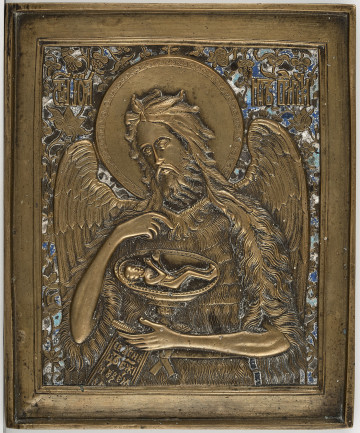
St. John the Baptist
20th century
Castle Museum in Łańcut
Part of the collection: Icons
The displayed fragment of an icon constitutes the third panel of a polyptych cast in brass and decorated with enamel, depicting events from the New Testament. The production of this type of folding paintings was developed on a large scale by the Old Believers, who did not recognise the liturgical reform in the 17th c. and, as a result, were separated from the official Moscow Orthodox Church. The creations of the Old Believers were popular throughout Russia, despite the restrictions put on them, e.g., the ban on casting such objects issued by Tsar Peter I in 1722. Starting with Pomeranian factories, metal objects of worship were reproduced and imitated in Moscow, the Volga region, Ural, and Syberia from the end of the 17th c. all the way until 20th c., see S.12780MŁ. Among the objects made by the Old Believers, there were the 'dwunadziesiatyje prazdniki' depicting the Twelve Great Feasts with the addition of popular Marian icons. On the displayed panel of the polyptych, complementing the holidays shown on S.12860MŁ, there are the following depictions: the Harrowing of Hell, the Ascension of Jesus, the Old Testament Trinity, and the Dormition of the Mother of God. On the kokoshnik at the top, there is a depiction of the Exaltation of the Holy Cross. Since the use of the moulding box began in the 18th c., metal icons were made by pouring the heated alloy into the mould, into the empty space left by the model’s imprint in clay. Models with single scenes (see S.12797MŁ) were used in order to create multi-panel folding icon wings. They were combined into completed arrangements which were joined with interlacing hinges after casting. On the face of the icon, when closed like a book, there is a depiction of Golgotha with an eight-pointed cross - the site of the Passion of Christ and of human salvation. When closing the icon, one would first fold the outer wings and then the two remaining ones, resulting in an icon the size of a single, but twice as thick, panel. Thanks to this, folding icons were readily used when traveling and as personal objects of worship. Teresa Bagińska-Żurawska https://orcid.org/0000-0002-9243-3967
Dimensions
height: 17.7 cm, width: 11.2 cm
Object type
Icons
Technique
cast, enamelling
Material
brass, varnish enamel
Origin / acquisition method
decyzja administracyjna
Creation time / dating
Creation / finding place
Owner
Castle Museum in Łańcut
Identification number
Location / status

20th century
Castle Museum in Łańcut

19th (?) century
Castle Museum in Łańcut

1800 — 1850
Castle Museum in Łańcut
DISCOVER this TOPIC
National Museum in Lublin
DISCOVER this PATH
Educational path